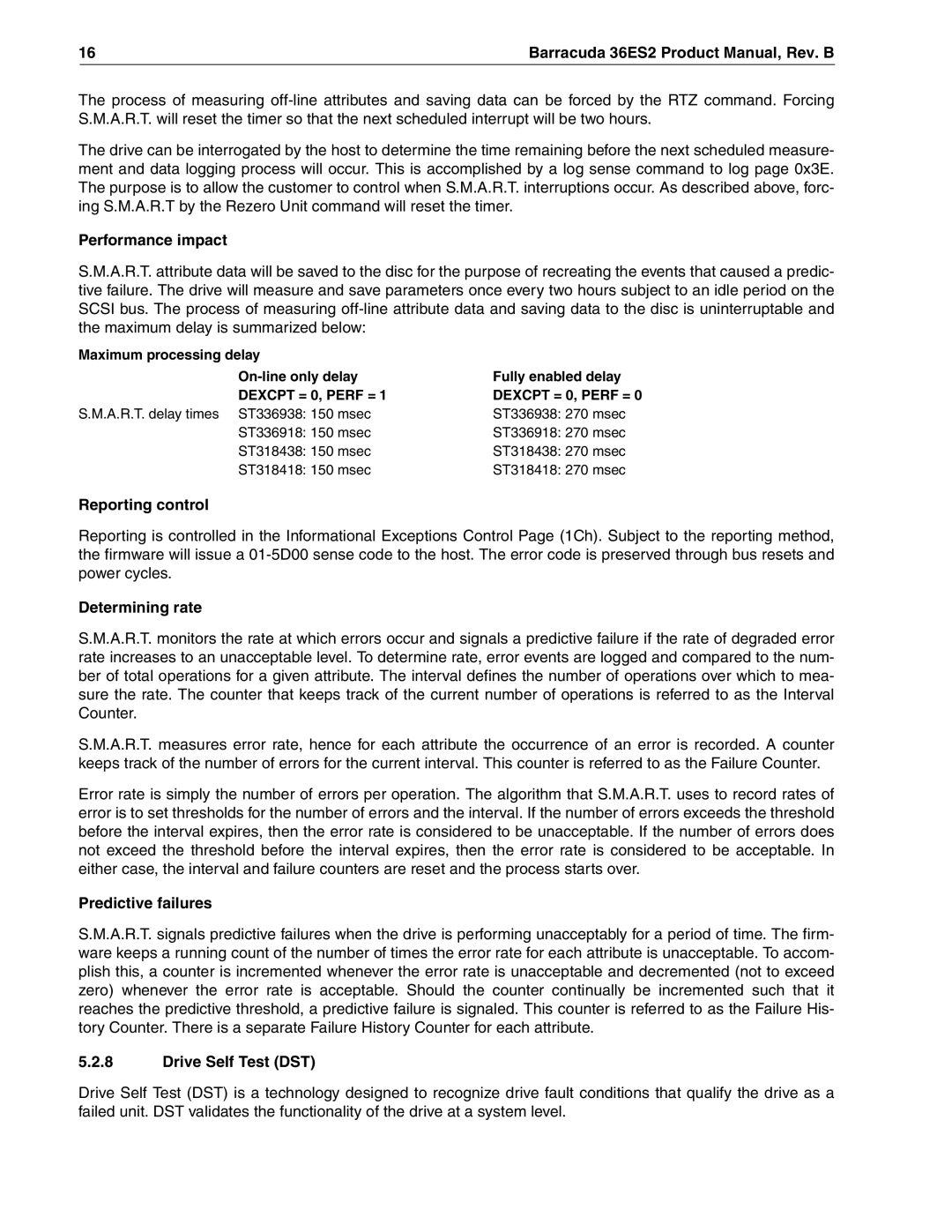16 | Barracuda 36ES2 Product Manual, Rev. B |
The process of measuring
The drive can be interrogated by the host to determine the time remaining before the next scheduled measure- ment and data logging process will occur. This is accomplished by a log sense command to log page 0x3E. The purpose is to allow the customer to control when S.M.A.R.T. interruptions occur. As described above, forc- ing S.M.A.R.T by the Rezero Unit command will reset the timer.
Performance impact
S.M.A.R.T. attribute data will be saved to the disc for the purpose of recreating the events that caused a predic- tive failure. The drive will measure and save parameters once every two hours subject to an idle period on the SCSI bus. The process of measuring
Maximum processing delay |
|
Fully enabled delay | |
DEXCPT = 0, PERF = 1 | DEXCPT = 0, PERF = 0 |
S.M.A.R.T. delay times ST336938: 150 msec | ST336938: 270 msec |
ST336918: 150 msec | ST336918: 270 msec |
ST318438: 150 msec | ST318438: 270 msec |
ST318418: 150 msec | ST318418: 270 msec |
Reporting control
Reporting is controlled in the Informational Exceptions Control Page (1Ch). Subject to the reporting method, the firmware will issue a
Determining rate
S.M.A.R.T. monitors the rate at which errors occur and signals a predictive failure if the rate of degraded error rate increases to an unacceptable level. To determine rate, error events are logged and compared to the num- ber of total operations for a given attribute. The interval defines the number of operations over which to mea- sure the rate. The counter that keeps track of the current number of operations is referred to as the Interval Counter.
S.M.A.R.T. measures error rate, hence for each attribute the occurrence of an error is recorded. A counter keeps track of the number of errors for the current interval. This counter is referred to as the Failure Counter.
Error rate is simply the number of errors per operation. The algorithm that S.M.A.R.T. uses to record rates of error is to set thresholds for the number of errors and the interval. If the number of errors exceeds the threshold before the interval expires, then the error rate is considered to be unacceptable. If the number of errors does not exceed the threshold before the interval expires, then the error rate is considered to be acceptable. In either case, the interval and failure counters are reset and the process starts over.
Predictive failures
S.M.A.R.T. signals predictive failures when the drive is performing unacceptably for a period of time. The firm- ware keeps a running count of the number of times the error rate for each attribute is unacceptable. To accom- plish this, a counter is incremented whenever the error rate is unacceptable and decremented (not to exceed zero) whenever the error rate is acceptable. Should the counter continually be incremented such that it reaches the predictive threshold, a predictive failure is signaled. This counter is referred to as the Failure His- tory Counter. There is a separate Failure History Counter for each attribute.
5.2.8Drive Self Test (DST)
Drive Self Test (DST) is a technology designed to recognize drive fault conditions that qualify the drive as a failed unit. DST validates the functionality of the drive at a system level.
